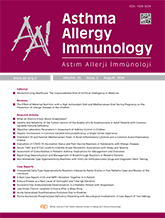


Although cases of late-onset localized rash after bee sting and localized cold urticaria after insect sting have been rarely reported, lateonset localized urticaria or recall urticaria after a wasp sting has not previously been reported as far as we are aware.
A 24-year-old male patient was stung once in the neck by a wasp in October 2018. After 15 minutes, the patient developed dizziness, fainting, flushing and dyspnea that resolved in a few hours with the treatment administered in the emergency room. One week after this event, a wasp stung his right arm and he fainted within 5-10 minutes. The patient vomited and recovered in a few hours with the treatment provided in the emergency room.
Approximately one month after the last wasp sting, skin lesions that were localized only to the right forearm and consistent with urticaria developed. There were no skin lesions in other parts of the body. While this complaint of the patient was under control with cetirizine 10 mg/day, it recurred every day if he did not use an antihistamine. This situation was not related to any trigger (cold, heat, drug use, etc.).
The Vespula spp. (10 mcg/mL) skin prick test was positive and the wasp-specific IgE level was found to be 56.2 IU/mL (class5). Vespula spp. subcutaneous immunotherapy was started and the patient has been on maintenance therapy for two years. No side effects related to immunotherapy have been observed so far. However, localized urticaria on the right forearm still persists in the absence of antihistamine use.
A very rare case of late onset chronic localized urticaria after a wasp sting is presented. Past history of wasp or bee stings should be questioned in cases of localized urticaria.